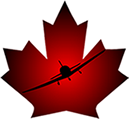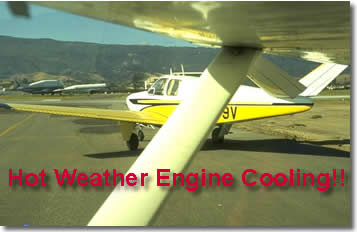 |
|
“Do
what we can, summer will have its flies.”
Summer is here. Clear skies beckon. Outside temperatures climb. It’s a great time to be a pilot. It’s a great time to take to the skies. It’s a great time, as well, to refresh ourselves on the necessary awareness, observations and precautions required to ensure we maintain safe operating temperatures and proper cooling of our trusty power plant. If we don’t properly feed and water the horses, they may balk at just the wrong moment. Light aircraft engines are almost all air-cooled. This cooling is achieved by a carefully designed system of directing outside air in through cowl openings, over the engine and back into the atmosphere during flight. Outside air passing over the engine carries away excess heat allowing the engine to maintain its normal temperature range. During winter months we operate in cooler temperatures; engine cooling is normally not a high priority. We are more concerned with ensuring that engine temperatures are sufficiently warm before we start down the runway for take off and that we cool the engine at a controlled rate to prevent shock cooling and potential damage to cylinders and other sensitive engine parts. During hot summer months, proper cooling and maintenance of proper temperature ranges can be very important. During pre-flight inspection confirm cowl openings are unobstructed, no debris, birds’ nests or other unwanted items have found their way into the engine compartment and that the air ducting forms a proper seal between the cowl and the aluminium baffles so air is properly directed over the engine and out the bottom of the cowling. It is not uncommon for the rubber or fabric material seals that close the gap between aluminium baffles and cowling and serve to direct cooling air over the engine to deteriorate over time. This will cause no significant difficulties when flying in cool temperatures, but in warm or hot conditions failure to fully exploit the cooling potential of air passing through the system can be a serious matter. The warmer the outside air the less potential it has for cooling the engine and the more important it is for all of it to pass through.
If the aircraft is equipped with cowl flaps, it is important to confirm they are operating properly, opening fully and are not obstructed by foreign debris. Before starting up, it may not be a bad plan to have a look at traffic on the ground. If you have hit a peak period of traffic movement, you may find yourself stuck on the ground longer than you might choose. If there is a long line-up of aircraft waiting for the run-up area, you might want to give it a moment while you review emergency procedures or complete some other useful chore. If you are operating from a large airport requiring complex radio clearances, it may be a plan to deal with the initial clearance delivery call prior to starting the engine and avoid extra idle time on the ground. As the Cessna 172M POH says, “Since the engine is closely cowled for efficient in-flight cooling, precautions should be taken to avoid overheating during prolonged engine operation on the ground.” Increasing idle rpm on the engine may add some slight additional airflow over the engine. It will also increase the heat production. For the most part, the air accelerated aft by the propeller does not increase cooling very much. The cowl openings are too close to the hub of the propeller and airflow is minimal. Prop wash may slightly increase the negative pressure at the cowl flaps and do a bit to assist cooling, but don’t count on too much help from higher rpm. The engine cooling system is not designed to operate efficiently while the aircraft is on the ground. We want to ensure proper operating temperatures are reached before takeoff, but we do not want the engine to overheat while running on the ground without proper cooling. Try to point the aircraft into prevailing wind for run-up and monitor temperature gauges. If you are equipped with cowl flaps, these will normally be in the open position while taxiing, during run-up and for take off to increase airflow over the engine. If your density altitude is high--often the case during hot weather--it may be appropriate to lean the mixture prior to takeoff to achieve full power. It is important, however, to keep in mind one of the functions of a little extra fuel passing through the cylinders: cooling. On takeoff and climb out, monitor your engine temperatures and increase the mixture, if required, to maintain proper temperature operating range. Climb provides an excellent opportunity for the engine to increase its temperature dramatically, if it is so inclined. We are producing lots of heat through combustion and, because of our relatively low air speed, are not producing a high volume of cooling airflow. On particularly hot days it may be a plan to use a slightly higher climb speed, consistent with safety, to increase the flow of cooling air. As Cessna’s 172M POH says, “…[use] speeds 5 to 10 knots higher than best rate-of-climb speeds for the best combination of performance, visibility and engine cooling.” During climb, cowl flaps will normally remain open to assist cooling. Once you have levelled out in cruise, allow the engine temperatures to stabilize before closing the cowl flaps and leaning mixture appropriately for cruise. Normally, in cruise there will be sufficient airflow for the engine to maintain a proper temperature range. Monitor temperature gauges on a regular cycle as part of your ever-vigilant cockpit checks to confirm all is well. During descent for landing cowl flaps will normally remain closed unless temperatures show unnaturally high. The typical phrase one sees is: “Cowl flaps: adjust as necessary for proper engine temperatures.” Usually, on descent and landing that will translate into cowl flaps closed to prevent the engine from cooling too quickly. If you need to abort the landing and perform an overshoot, open cowl flaps to prevent engine temperatures from rising above operating limitations. For aircraft with no cowl flaps, ensure the mixture in appropriately rich and the carburetor heat is set to cold. Maintain appropriate climb speeds to provide adequate cooling airflow. Shutting down the engine may result in a temporary rise in the temperature, but should not cause undue problems. Some mechanics recommend that the cowl flaps be left open during cool down to facilitate even cooling of the engine. The biggest problem most of us will run into with cooling is that the fuel injection unit, on the C-206 for example, sits on top of the engine and will be subjected to considerable heat as it dissipates from the rest of the machine. This can result in vapour lock and make it difficult to start the engine again before it has had a chance to cool. Flying in the warm days of summer can be a delight, but it holds its own set of challenges. Learning to understand and deal with them successfully is all part of being a proficient pilot. Enjoy.
|



